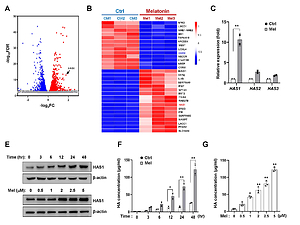Current issue
Archive
Manuscripts accepted
About the Journal
Editorial office
Editorial board
Section Editors
Abstracting and indexing
Subscription
Contact
Ethical standards and procedures
Most read articles
Instructions for authors
Article Processing Charge (APC)
Regulations of paying article processing charge (APC)
ORTHOPEDICS AND TRAUMATOLOGY / RESEARCH PAPER
Melatonin Enhances Chondrocytes Survival Through Hyaluronic Acid Production and Mitochondria Protection
1
Tianjin Medical University, China
2
Tianjin First Central Hospital, China
3
Logistics University of People's Armed Police Force, China
4
Houston Methodist Hospital, United States
Submission date: 2020-12-22
Final revision date: 2021-04-22
Acceptance date: 2021-05-03
Online publication date: 2021-05-09
KEYWORDS
TOPICS
ABSTRACT
Introduction:
Melatonin, an indoleamine synthesized mainly in the pineal gland, plays a key role in regulating the homeostasis of bone and cartilage. Reactive oxygen species (ROS) are released during osteoarthritis (OA) and associated with cartilage degradation. Melatonin is a potent scavenger of ROS.
Material and methods:
We used rat chondrocytes as a research objective in our study and investigated the effect of melatonin. We evaluated cell viability by MTS, cell apoptosis and mitochondrial transmembrane potential (MMP) by flow cytometry, hyaluronic acid (HA) concentrations by ELISA assay, relative gene and protein expression by RT-qPCR and WB assay, the subcellular location of nuclear factor κB (NF-κB) p65 and Rh-123 dye by immunofluorescence, oxygen consumption rate (OCR) by Seahorse equipment.
Results:
MTS and flow cytometry assay indicated that melatonin prevented H2O2-induced cell death. Melatonin suppressed the expression of HAS1 both from mRNA and protein level in time- and dose-dependent manners. Furthermore, melatonin treatment attenuated the decrease in HA production in response to H2O2 stimulation and repressed the expression of cyclooxygenase-2 (COX-2). Melatonin significantly decreased the nuclear volume of p65 and inhibited the expression of p50 induced by H2O2. In addition, melatonin restored the MMP and OCR of mitochondria, exerted mitochondrial protection function.
Conclusions:
Melatonin has a protective effect on chondrocytes, possibly by upregulating HA synthesis and inhibiting the NF-kB signaling.
Melatonin, an indoleamine synthesized mainly in the pineal gland, plays a key role in regulating the homeostasis of bone and cartilage. Reactive oxygen species (ROS) are released during osteoarthritis (OA) and associated with cartilage degradation. Melatonin is a potent scavenger of ROS.
Material and methods:
We used rat chondrocytes as a research objective in our study and investigated the effect of melatonin. We evaluated cell viability by MTS, cell apoptosis and mitochondrial transmembrane potential (MMP) by flow cytometry, hyaluronic acid (HA) concentrations by ELISA assay, relative gene and protein expression by RT-qPCR and WB assay, the subcellular location of nuclear factor κB (NF-κB) p65 and Rh-123 dye by immunofluorescence, oxygen consumption rate (OCR) by Seahorse equipment.
Results:
MTS and flow cytometry assay indicated that melatonin prevented H2O2-induced cell death. Melatonin suppressed the expression of HAS1 both from mRNA and protein level in time- and dose-dependent manners. Furthermore, melatonin treatment attenuated the decrease in HA production in response to H2O2 stimulation and repressed the expression of cyclooxygenase-2 (COX-2). Melatonin significantly decreased the nuclear volume of p65 and inhibited the expression of p50 induced by H2O2. In addition, melatonin restored the MMP and OCR of mitochondria, exerted mitochondrial protection function.
Conclusions:
Melatonin has a protective effect on chondrocytes, possibly by upregulating HA synthesis and inhibiting the NF-kB signaling.
Share
RELATED ARTICLE
We process personal data collected when visiting the website. The function of obtaining information about users and their behavior is carried out by voluntarily entered information in forms and saving cookies in end devices. Data, including cookies, are used to provide services, improve the user experience and to analyze the traffic in accordance with the Privacy policy. Data are also collected and processed by Google Analytics tool (more).
You can change cookies settings in your browser. Restricted use of cookies in the browser configuration may affect some functionalities of the website.
You can change cookies settings in your browser. Restricted use of cookies in the browser configuration may affect some functionalities of the website.



